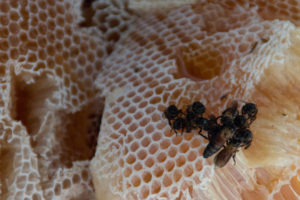
The tamanu tree (Calophyllum inophyllum) has been helping humans out since prehistoric times.
Tamanu is native to tropical Asia, and was carried by Austronesians on their migrations to Oceania and Madagascar: the tree was as valuable to these voyagers as oak was to their European counterparts. Also known as mastwood, tamanu has been used by shipbuilders for millennia because it grows tall and strong in sandy, rocky areas.
In Polynesia, indigenous groups affectionately refer to the tamanu tree as “beauty leaf,” as they use the oil from the fruit kernel as a moisturiser and healing balm. They also use it as a hair grease and painkiller. These days, tamanu oil is used internationally in a range of skin and hair-care products.
Now, the fragrant, deep brown oil may serve another purpose: bioenergy. A mature tamanu grove can yield up to 20 tons of crude oil per hectare each year. In Wonogiri district of Central Java, Indonesia, a new study shows that cultivating tamanu for bioenergy on degraded land can achieve multiple benefits for farmers while restoring the land, as well as helping to reduce the country’s reliance on fossil fuels.
Beyond oil palm
Indonesia has pledged to increase its biodiesel and bioethanol consumption to 30 percent and 20 percent respectively, of total energy consumption by 2025. However current levels of biofuel production are far from meeting these targets, and boosting production at the scale required comes with its own environmental challenges.
So far, almost all of the biofuel produced in the country has come from oil palm. But land conversion from food cropping to oil palm for biodiesel has an impact on food security. In many cases oil palm plantations have encroached upon rainforests and peatlands, threatening biodiversity and releasing carbon into the atmosphere.

This is why researchers have begun exploring alternative bioenergy options, looking at species with multiple uses that can grow on degraded land on which other crops struggle. A recent study showed that there are around 3.5 million hectares of degraded land across Indonesia that would be suitable for growing at least one of five key biodiesel and biomass species, including tamanu. As well as bioenergy, these crops are capable of improving soil function and boosting biodiversity, thus playing an important role in restoring the land.
Infographic: Nyamplung (Calophyllum inophyllum): Alternative bioenergy crop and powerful ally for land restoration
Farmers hit the honeypot
Planting trees on degraded lands is difficult, and the returns are slow. Farmers need other sources of income, too, if tamanu cultivation for biofuel is to be sustainable.
In Wonogiri, scientists from the Center for International Forestry Research (CIFOR), whose work is part of the CGIAR Research Program on Forests, Trees and Agroforestry (FTA), together with the Center for Forest Biotechnology and Tree Improvement Research and Development (CFBTI) and the Korean National Institute of Forest Science (NIFOS) sought to find out if the figures add up in the farmers’ favor.
They collected data from 20 farmers who grow tamanu on degraded land (which locals call nyamplung). The farmers intercrop the tree with maize, rice and peanuts, and make use of it in honey production.
The researchers found that while the rice and peanuts were not profitable, and the maize was only marginally so, farmers grew them anyway to feed their families. The big money, however, lay in honey production, which was almost 300 times more profitable than maize, said CIFOR scientist Syed Rahman. “We were all surprised to see just how profitable it was,” he added.
The results suggest that tamanu can be grown sustainably as part of an agroforestry system that also utilises honey production and subsistence crops in the area. What is needed now, says CFBTI senior scientist and professor Budi Leksono, is for the market for biofuels to be developed further to create economies of scale.
“The market for nyamplung oil is not really developed yet,” said Leksono. “But we’re anticipating an energy crisis, and [by doing this work now] we are preparing for the plantations of the future.”
However, the policy around this needs to be designed extremely carefully, cautioned Rahman. “Because it’s potentially so profitable,” he explained, “the risk is that people will expand this system to forestland, too.” He added that careful constraints must be applied to ensure it is cultivated only on degraded and underutilized lands.
The implications are exciting. As CIFOR senior scientist Himlal Baral noted, while national and global interests and commitments for forest landscape restoration are increasing, success so far has been limited by a lack of solid business cases or financial viability. “In order for funding to flow into landscape restoration, it needs to be profitable,” he said.
Tamanu-based systems may well offer a compelling case for restoration that is worth everybody’s while.
By Monica Evans, originally published at CIFOR’s Forests News.
This research forms part of the CGIAR Research Program on Forests, Trees and Agroforestry, which is supported by the CGIAR Trust Fund.
This research was supported by the CIFOR Bioenergy project funded by NIFoS (National Institute of Forest Science, South Korea).











